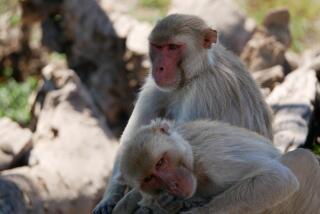Oral Sex Linked to Greater Risk of AIDS in Monkeys
- Share via
The AIDS virus is much more likely to be transmitted through oral sex than researchers had previously believed, according to a new study of monkeys.
If confirmed, the results would contradict the conventional wisdom among heterosexuals and homosexuals that this form of sex is safer than anal or vaginal intercourse.
Using the simian immunodeficiency virus, the monkey equivalent of HIV, researchers at the Dana-Farber Cancer Institute report today in the journal Science that virus placed into the mouths of the animals was far more infectious than virus placed in their rectums.
In humans, however, scrapes and tears caused by anal intercourse would still make that route more hazardous than oral sex, the researchers said. Nevertheless, the new findings should generate public concern, particularly in the gay community, where unprotected oral sex remains a common practice.
“On the basis of our study, unprotected receptive oral intercourse should be added to the list of behaviors that place people at risk for infection by HIV-1,” the most common form of the AIDS virus, said Dr. Ruth M. Ruprecht.
Critics, however, charged that epidemiological studies in humans give no indication that oral sex is a major risk factor. They contend that the high rate of infection observed in Ruprecht’s monkey studies was an artifact of the experimental conditions.
“The data have to be taken seriously, but they certainly don’t square with the epidemiology to date,” said epidemiologist Kenneth Mayer of the Brown University AIDS program. Nonetheless, he said, men and women “should definitely feel some caution in engaging in oral sex.”
“My feeling is, why put yourself at risk?” said Dr. Roger Detels of the UCLA AIDS Institute. “And there definitely is some risk” in oral sex.
Both sides stressed that the new data do not indicate any increased risk from kissing or other casual contact. The concentration of HIV in saliva is too low for transmission, said Dr. Jerome Zack of the UCLA AIDS Institute. “There is really very, very little virus in saliva,” he said.
It has long been known that HIV can be transmitted via oral sex, “but the cases clearly proved to be associated with it are few and far between,” Mayer said.
Confounding researchers’ ability to assess the problem is that men who practice oral sex usually engage in anal sex as well. When epidemiologists see an HIV-positive individual with several risk factors, they tend to attribute the infection to the factor they believe to be the most likely cause, and that is generally anal sex, he said.
As recently as March, the Gay and Lesbian Medical Assn. released a position paper classifying oral sex as “low risk.”
“I think that the trend among gay men, and all populations, has been to perceive oral sex as a much lower risk activity,” said Lee Klosinski, director of education for AIDS Project L.A. “Our position has been to tell people that it has a lower risk, but that does not mean no risk.”
The new study, he added, “will influence the information we give out.”
Because ethical considerations prevent researchers from studying infections in humans, they frequently use monkeys, which are most similar to humans in their reaction to AIDS. New AIDS drugs and vaccine candidates are routinely tested in primates before they are used in humans. “The model they are using, the monkey system, is probably the best model that we have to look at transmission of a virus similar to HIV,” Zack said.
In their experiment, Ruprecht and her colleagues placed a small dose of SIV on the back of the tongues of seven macaque monkeys. Six developed AIDS and two have died.
“We were surprised to find that the minimal dose needed to achieve infection after oral exposure . . . was 6,000 times lower than that needed for rectal infection,” Ruprecht said.
But that does not mean that the risk among humans for acquiring HIV infection through oral sex is higher than that for anal sex, she said. Anal sex almost always produces minute tears in rectal tissue that greatly increase the ability of the virus to pass into the body. The monkeys had no such tears.
“Based on this study, you probably can’t draw a conclusion about which route is safer in humans,” Zack said. “But it does show that you can transmit the virus by the oral route. . . . It’s quite interesting.”
The risk of contracting AIDS during anal sex is estimated at 5 to 30 infections per 1,000 acts. For vaginal sex, the risk to females is one in 1,000.
No good data is available for oral sex, Detels said, but he has previously estimated that people who participate in anal sex are 30 times more likely to develop AIDS than those who participate only in oral sex. How the latest results might alter that risk is not certain, he said.
Although Ruprecht’s study is apparently the first to attempt to demonstrate oral transmission in monkeys, it has already been partially replicated. Primatologist Christopher Miller of UC Davis has also found a high rate of oral infection in monkeys, but his paper has not been published.
Miller attributes his results to the fact that captive adult primates often have gingivitis in the junction between the teeth and gums. These lesions, like rectal tears, would allow the virus to pass more readily.
Ruprecht said her animals were all young and free of gingivitis.
The implications of the experiments for humans are not completely clear, Detels said. “First, monkeys are not men. There are always some issues about generalizing from monkey experiments to humans,” he said. “Second, SIV is not HIV. They are distinct viruses.” And third, he said, the rectal tissue in the monkeys was not damaged as it would be in anal sex.
All those factors need to be taken into consideration, he said. “But the bottom line is that those of us who have worked in the field are not surprised that it is possible to be infected by the oral route.”





